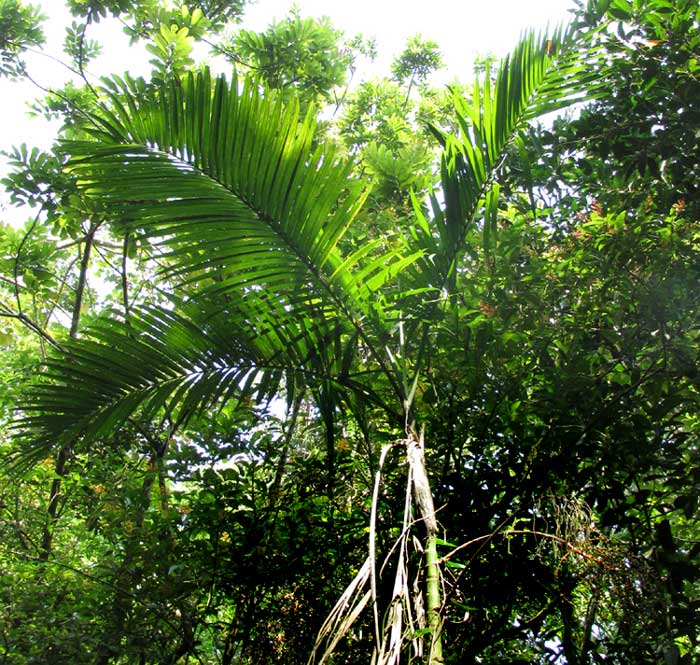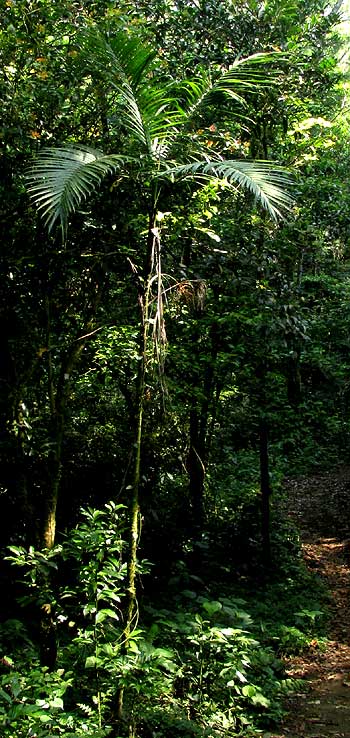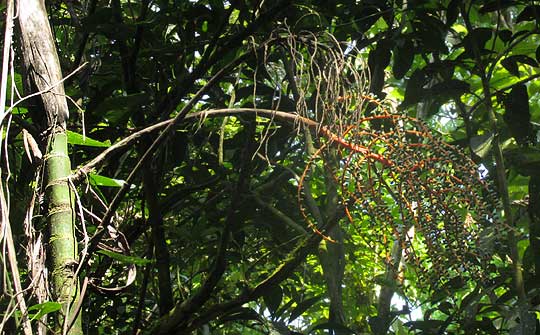Excerpts from Jim Conrad's
Naturalist Newsletter

notes from the May 10, 2015 Newsletter describing a camping trip, in the last week of April, in the hydrological reserve above San AndrésTuxtla, Veracruz, México; elevation ~1180m (5900ft), ~N18.52°, ~W95.15°
WOODSON'S CHAMAEDOREA PALM

During the last week in April I camped in the mountain-top hydrological reserve above and to the north of San Andrés Tuxtla, Veracruz, Mexico. The reserve's cloud forest was particularly rich in species of the palm genus Chamaedorea. Most Chamaedorea palms are so small that often they are grown indoor in pots or small gardens, and are known as parlor palms. Chamaedorea palms bear feather-type, pinnately compound fronds like Coconut Palms, but instead of a few large coconut-type fruits their panicle-type flowering and fruiting heads typically consist of numerous spherical, pea-sized drupes attached to thick, orangish branches (the rachis and rachillae). Fronds of smaller Chamaedorea species often are cut from forest trees and sold as slow-to-wilt greenery used as decoration during weddings and funerals. Over a hundred Chamaedorea palms are recognized, all native to the tropical and subtropical Americas.
In the reserve's forest during my late-April visit the smaller Chamaedorea palms were not flowering or fruiting, but one exceptionally large species was. At the top of this page you can see it standing along a forest trail about 20 feet tall (6m).
Notice that its trunk is uncommonly slender for such a tall tree, and that only a single trunk is produced, in contrast to the multiple, bunched trunks of many Chamaedorea species. This tree has produced a large cluster of fruits -- an "infructescence" -- loaded with dozens of tiny drupes, barely visible projecting from the trunk's right side about a meter below the leaves. In the picture at the top of this page the infructescence is more visible occupying the lower, right corner:
An even closer look at the heavily laden infructescence is shown below:

This is CHAMAEDOREA WOODSONIANA, occurring in wet mountain forests and cloud forests from southern Mexico and Belize south to Costa Rica, and possibly in Colombia in South America. It doesn't have a decent English name, though Woodson's Chamaedorea probably would do.
In Mexico's Tuxtlas area there's another similar-sized Chamaedorea palm, Chamaedorea tepejilote, the Pacaya, whose immature flowering heads when harvested can be cooked and eaten like boiled corn-on-the-cob. The dish is so favored by some that cultivars have been developed with sweeter tasting heads. Chamaedorea woodsoniana differs from the Pacaya, however, by its infructescences bearing more numerous and smaller fruits than the Pacaya.